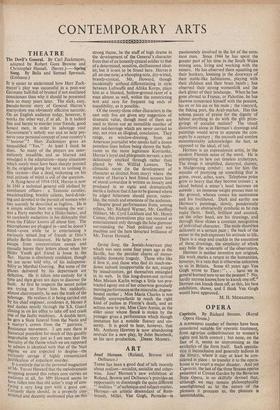ART
THERE has been a good deal of talk recently about realism—socialist, socialite and other- wise. Josef Herman's new exhibition at Roland, Browse and Delbanco's prOvides an opportunity to disentangle the quite different " realities " of technique and subject-matter. Herman—an artistic descendant of Rem- brandt, Millet, Van Gogh, Permeke—is passionately involved in the lot of the com- mon man. Since 1944 he has spent the greater part of his time in the South Wales mining area, living and working with the miners. He has observed them squatting on their hunkers, looming in the doorways of their stable-like habitations, playing with their children and their brass bands ;. has observed their strong womenfolk and the dark glitter of their landscape. When'he has gone abroad to France, or Palestine, he has likewise concerned himself with the peasant, his ox or his ass or his mule ; the vineyard, the fishing port, the Arab market. Has this solemn paean of praise for the dignity of labour anything to do with the glib prize- givings of socialist realism? The visual distortions alone in Herman's drawings and paintings would serve to separate the con- cepts by a century ; the uncouth and sombre monumentality acknowledges the fact, as opposed to the ideal, of toil. • Herman is an expressionist artist, in the modern Flemish sense of the word. He is attempting to hew out timeless archetypes. The image is simplified, distorted, clumsy, a bludgeoning symbol ; not for him the mistake of prettying up something that is grime, sweat, aches, scars. Telephone poles grow so heavy that they become crosses ; a cloud behind a miner's head becomes an aureole ; an immense weight presses man to the ground, whence comes his sustenance and his livelihood. Dark and earthy are Herman's paintings, slowly, ponderously built up, as abstractedly symbolic as he can make them. Swift, brilliant and assured, on the other hand, are his drawings, and through these shines a constant recognition of individual character. The mule shambles delicately at a certain pace ; the back of the miner in the pub expresses his attitude to life. There is a snap and crackle in the execution of these_drawings, the simplicity of which may belie the acuteness of the observation, Herman is neither inventive nor original. His work marks a return to the humanities, however, in a vein that is otherwise unknown to us in Britain. Some 65 years ago Van Gogh wrote to Theo : " . . . have we in general learned now to see the peasant ? No, hardly anyone knows how to knock one off." Herman can knock them off, as this, his best exhibition, shows, and I think Van Gogh would have approved.
M. H. MIDDLETON.


















































 Previous page
Previous page